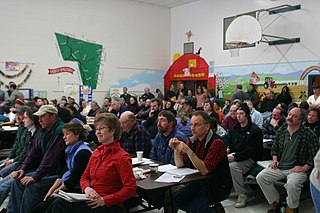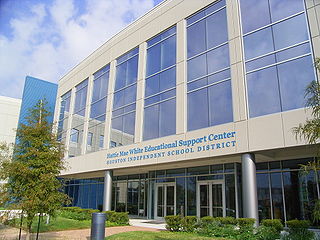Related Research Articles
A school district is a special-purpose district that operates local public primary or secondary schools or both in various countries.

Town meeting, also known as an "open town meeting," is a form of local government in which eligible town residents can directly participate in an assembly which determines the governance of their town. Unlike representative town meeting where only elected representatives can participate in the governing assembly, any town voter may participate in an open town meeting. This form is distinct from town hall meetings held by elected officials to communicate with their constituents, which have no decision-making power.

The administrative divisions of New York are the various units of government that provide local services in the U.S. State of New York. The state is divided into boroughs, counties, cities, towns, and villages. They are municipal corporations, chartered (created) by the New York State Legislature, as under the New York State Constitution the only body that can create governmental units is the state. All of them have their own governments, sometimes with no paid employees, that provide local services. Centers of population that are not incorporated and have no government or local services are designated hamlets. Whether a municipality is defined as a borough, city, town, or village is determined not by population or land area, but rather on the form of government selected by the residents and approved by the New York State Legislature. Each type of local government is granted specific home rule powers by the New York State Constitution. There are still occasional changes as a village becomes a city, or a village dissolves, each of which requires legislative action. New York also has various corporate entities that provide local services and have their own administrative structures (governments), such as school and fire districts. These are not found in all counties.

The University of the State of New York is the state of New York's governmental umbrella organization for both public and private institutions in New York State. The "university" is not an educational institution: it is, in fact, a licensing and accreditation body that sets standards for schools operating in New York State, from pre-kindergarten through professional and graduate school, as well as for the practice of a wide variety of professions. USNY's governing body is known as the New York State Board of Regents.
A town council, city council or municipal council is a form of local government for small municipalities.
The Boards of Cooperative Educational Services is a program of shared educational services provided to school districts by the New York State Legislature.
The State of New Hampshire has a republican form of government modeled after the Government of the United States, with three branches: the executive, consisting of the Governor of New Hampshire and the other elected constitutional officers; the legislative, called the New Hampshire General Court, which includes the Senate and the House of Representatives; and the judicial, consisting of the Supreme Court of New Hampshire and lower courts.
Massachusetts shares with the five other New England states a governmental structure known as the New England town. Only the southeastern third of the state has functioning county governments; in western, central, and northeastern Massachusetts, traditional county-level government was eliminated in the late 1990s. Generally speaking, there are four kinds of public school districts in Massachusetts: local schools, regional schools, vocational/technical schools, and charter schools.

The School District of the Chathams is a regional public school district serving students in pre-kindergarten through twelfth grade from Chatham Borough and Chatham Township in Morris County, in the U.S. state of New Jersey.
The Morris School District is a comprehensive public school district that serves students in pre-kindergarten through twelfth grade from three municipalities in Morris County, in the U.S. state of New Jersey. The communities in the district are Morristown and Morris Township, along with students from Morris Plains in grades 9-12 who attend the district's high school as part of a sending/receiving relationship with the Morris Plains Schools.
The North Hunterdon-Voorhees Regional High School District is a regional, four-year public high school district, that serves students in ninth through twelfth grades from twelve municipalities in northern Hunterdon County, in the U.S. state of New Jersey. Students in the district are from Bethlehem Township, Califon Borough, Clinton Town, Clinton Township, Franklin Township, Glen Gardner Borough, Hampton Borough, High Bridge Borough, Lebanon Borough, Lebanon Township, Tewksbury Township and Union Township.
A municipal council is the legislative body of a municipality or local government area. Depending on the location and classification of the municipality it may be known as a city council, town council, town board, community council, rural council, village council, or board of aldermen.

The New York State Education Department (NYSED) is the department of the New York state government responsible for the supervision for all public schools in New York and all standardized testing, as well as the production and administration of state tests and Regents Examinations. In addition, the State Education Department oversees higher education, cultural institutions such as museums and libraries, vocational rehabilitation, and the licensing of numerous professions. It is headed by the Board of Regents of the University of the State of New York (USNY) and administered by the Commissioner of Education.
Memphis-Shelby County Schools(MSCS), previously known as Shelby County Schools (SCS), is a public school district that serves the city of Memphis, Tennessee, United States, as well as most of the unincorporated areas of Shelby County. MSCS is the 23rd largest school district in the United States and the largest in Tennessee.
Every Chicago public school has a Local School Council (LSC) which consists of parents, community members, teachers, and the principal of the school. Members of the council are elected except in the case of teachers, staff and student representatives, who are appointed by the Board of Education after non-binding polls are taken and conduct monthly meetings which the public can attend. Their primary responsibility is to select the school's principal, renew the principal's contract, approve the Continuous Improvement Work Plan (CIWP) and approve the school's budget for the school year. Some LSCs serve only in an advisory capacity, such as with low-performing schools undergoing turnarounds.
The Williamson Central School District is a public school district that serves the residents of the Town of Williamson, New York, USA. It has three campuses: an elementary/primary school serving grades pre-kindergarten–4; a middle school for grades 5–8; and a senior high school comprising grades 9–12. The system had 1,336 students in Kindergarten–12 and a senior class of 99 during the school year 2004/5. There were 125 teachers and 78 other professional and paraprofessional staff.

An independent school district (ISD) is a type of school district in some US states for primary and secondary education that operates as an entity independent and separate from any municipality or county, and only under the oversight of the respective state government. As such, the administrative leadership of such districts is selected from within the district itself and has no direct responsibility to any other governmental authority. This independence normally also implies that the district has its own taxing authority that is outside the direct control of other governmental entities.
Local government in New Jersey is composed of counties and municipalities. Local jurisdictions in New Jersey differ from those in some other states because every square foot of the state is part of exactly one municipality; each of the 564 municipalities is in exactly one county; and each of the 21 counties has more than one municipality. New Jersey has no independent cities, or consolidated city-counties.
Education in Maine consists of public and private schools in Maine, including the University of Maine System, the Maine Community College System, private colleges, and secondary and primary schools.
The administrative divisions of Ohio are counties, municipalities, townships, special districts, and school districts.
References
- 1 2 3 4 "What Does "Union Free" Mean?". East Rochester Union Free School District. Retrieved January 29, 2021.
- ↑ "Section 1703 Change in number of members of board of education". The Laws of New York - Consolidated Laws - Education - Title 2: School District Organization - Article 35: Union Free School Districts. New York State Senate. Retrieved February 19, 2021.